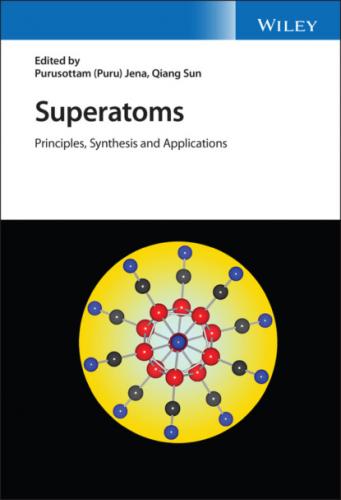Source: Han and Jung [33]. © American Chemical Society.
For superatoms to be used as building blocks of cluster‐assembled materials, it is important that not only they be stable and mimic the chemistry of atoms but also they should remain in their virgin form when forming a crystal. Liu et al. [35] studied the stability of a KAl13 crystal confined to the CsCl structure. The hypothesis was that Al13 − clusters will stay apart from each other due to the negative charge they carry. On the contrary, they found that the Al atoms in neighboring Al13 clusters interact and KAl13 as a crystal was unstable. To determine whether changing the cation from a metal to a nonmetallic one would result in stabilizing the Al13 − icosahedral geometry, Huang et al. [36] recently studied the stability of [(CH3)4N+][Al13 −] crystal. Note that the ionization potential of (CH3)4N+ is 3.27 eV, which is even smaller than that of a K atom, namely, 4.34 eV. In addition, the diameter of (CH3)4N+ is 4.2 Å, which is comparable to the diameter of Al13, namely 5.3 Å. The binding energy of [(CH3)4N+][Al13 −] cluster, namely 2.68 eV, is also larger than that of KAl13 cluster, which is 2.49 eV. Expecting that a crystal of [(CH3)4N+][Al13 −] may be stable with both the cation and the anion maintaining their individual geometry, Huang et al. confined the initial crystal structure to three forms – (i) body‐centered‐cubic, (ii) rock salt, and (iii) zinc‐blende phases, which are common crystal structures of binary salts (e.g., CsCl, NaCl, and ZnO) (see Figure 2.11). After optimization, the results show that while the (CH3)4N maintains its structure in all of the above systems, Al13 clusters coalesce, ceasing to remain as individual clusters. It is, thus, safe to conclude that stable metallic clusters with electronic closed shells are not good candidates for cluster‐assembled materials.
Figure 2.11 Initial crystal structure for (a) body‐centered‐cubic (bcc), (b) rock salt (rs), and (c) zinc‐blende (zb) phases of (CH3)4N+Al13− bulk. (d) Optimized structures of (CH3)4N+Al13− show the coalescence of Al13 clusters when forming a bulk material.
Source: Huang [36]. © American Chemical Society.
On the contrary, jellium shell closure rule has been effectively used to explain the stability of ligated metal clusters, particularly ligated Cu, Ag, and Au clusters. As the number of atoms in the metal core as well as the number and type of ligands can be varied independently, one is gifted with considerable flexibility to design ligated metal clusters as superatoms. Consider, for example a metal core consisting of NC number of core atoms and NS number of surface atoms. The surface atoms are the ones that bind to the ligands forming either an ionic or a covalent bond. If the number of valence electrons in the core atoms correspond to shell closure, it is likely that such a cluster can gain unusual stability. Hakkinen and coworkers [37, 38] used this approach to explain the unusual stability of some ligated Al and Au clusters. For example, the unusual stability of Al50Cp*12 can be explained by realizing that 12 Cp* ligands withdraw 12 electrons from the Al50 core, thus leaving 50 × 3 − 12 = 138 electrons. This is just enough electrons to close the 1I superatom jellium shell. Similarly, the authors showed that ligand‐protected Au clusters, satisfying electron shell closure at 8, 34, and 58, can indeed be synthesized.
That stable ligated metal clusters consistent with the jellium shell closure rule can be synthesized has been verified by experiments. Some of these clusters include Au25(SR)18 − [39] and As7 and As11, with cryptated alkali atoms [40, 41]. However, it has been pointed out that the strength of the ligand interaction and its effect on the geometry on the metal core play an important role in the electron counting [33, 42, 43]. Examples of some ligated clusters consistent with the jellium model are given in Table 2.1.
2.2.2 Octet Rule
The octet rule was developed in early 1900s to account for the chemistry of low atomic number (<20) elements [8–10]. The noble gas atoms, with their outer electron configuration of ns 2 np 6, have closed electronic shells and hence, a large HOMO–LUMO gap, high ionization potential, and low electron affinity. Thus, they are very stable and chemically inert. A variety of superatomic clusters containing elements with low atomic number can be designed such that constituent atoms satisfy the octet shell closure. We begin with the description of Group 1 alkali and Group 17 halogen atoms.
Table 2.1 Examples of ligated clusters with effective number (ne) of valence electrons for jellium shell closure.
| ne | Examples |
|---|---|
| 2 | Ag14(SR)12(PR)8, Ag16(SR)14(dppe)4, {Au34[Fe(CO)3]6 [Fe(CO)4]8}8− |
| 8 | Au11X3(PR3)7, [Au13Cl2(PR3)10]3+, [Au25(PET)18] −, Au28(SR)20, Al4(C5Me5)4, Al4[SiC(CH3)3]4, [Au13Cu2(PR)6(SPy)6]+, [Au13Cu4(PR2Py)4(SR)8]+, [Au13Cu8(SPy)12]+, [Au11(dpdp)6]3+, {Ag21[S2P(O/Pr)2]12}+ |
| 18 | [Ag44(SR)30]−4, [Ag44(SR)30]−4, [Au12Ag32(SR)30]−4, [Au12+nCu32(SR)30+n]−4 (n = 0, 2, 4, 6), Au24Ag20(SR)4(C2Ph)20Cl2 |
| 34 | [Au39(PR3)14Cl6]−, Au68(SR)34, [Au67(SR)35] −2, Au39Cl6(PH3)14 |
| 40 | {Ge9[Si(SiMe3)3]3}−, SiAl14(C5Me5)6 |
| 58 | Au102(p‐MBA)44, Au102(SMe)44, {GaGa11[GaN(SiMe3)2]11} |
| 138 |
Al50(C5Me5)12
|
